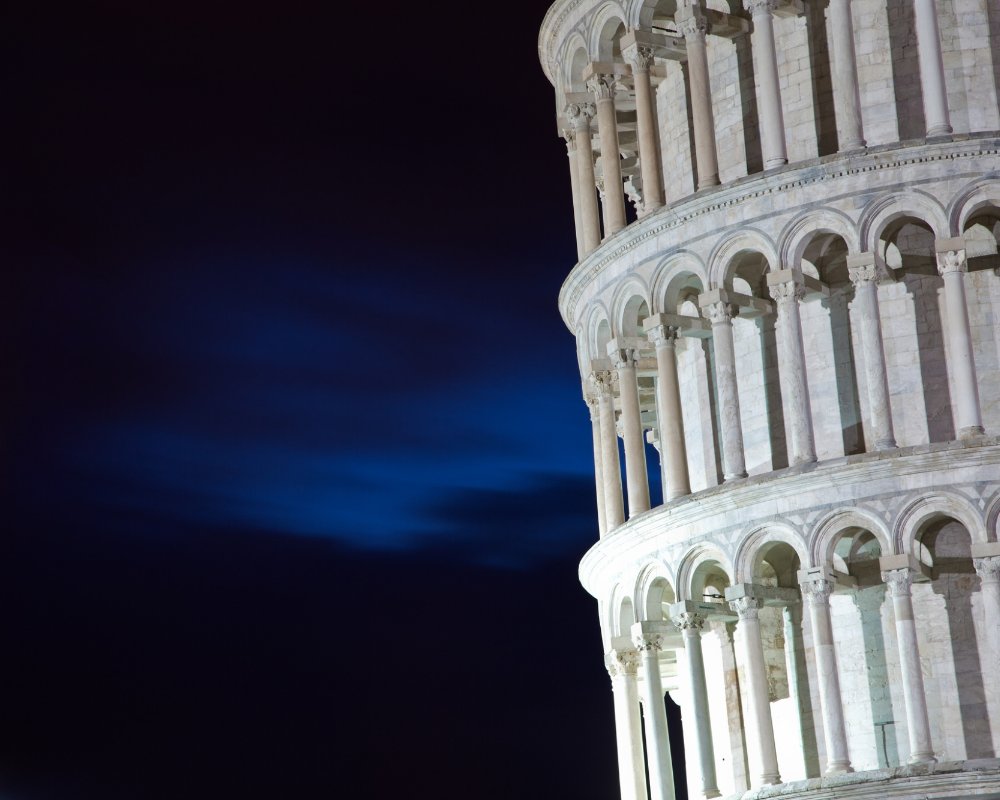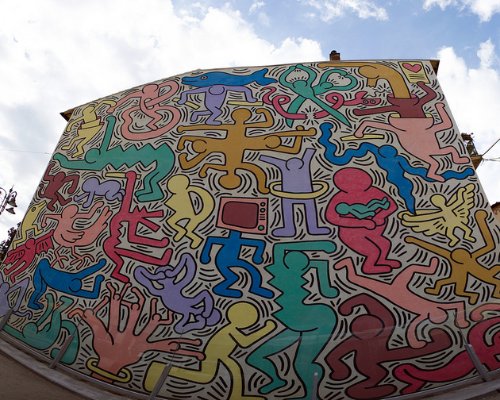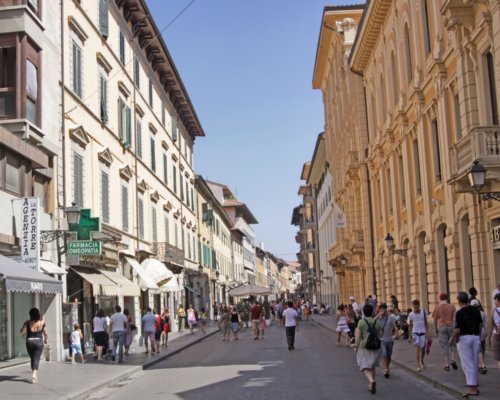A tour of Pisa in one day starting from the Central Station
It is always better to stay a long time in a city, in order to discover all the hidden places and better understand its culture and traditions… but if you just have one day to spend in a town: you should optimize your time! Today we're going to Pisa, from dusk to dawn, in a 10-step trip. Here we go!
You'll probably arrive at the Central station or at the Galileo Galilei International Airport. Anyway, at the airport you can take the PisaMover and reach Pisa Centrale in a few minutes. So let's consider this the starting point of the trip.
Going straight from the train station to the city center, the first big square you'll see is Piazza Vittorio Emanuele II. Recently restored, it has soon become one of the preferred meeting places in Pisa. During winter, you can find there an ice rink for skating, and all year long you can stop to have a drink in one of the bars that overlook the square. On the left of the square, you'll discover one of the hidden jewels of Pisa: in the Sant'Antonio square, in one of the walls of the church with the same name, there is Keith Haring's mural called "Tuttomondo". Even some people in Pisa don't know of its existence!
Going straight from the train station to the city center, the first big square you'll see is Piazza Vittorio Emanuele II. Recently restored, it has soon become one of the preferred meeting places in Pisa. During winter, you can find there an ice rink for skating, and all year long you can stop to have a drink in one of the bars that overlook the square. On the left of the square, you'll discover one of the hidden jewels of Pisa: in the Sant'Antonio square, in one of the walls of the church with the same name, there is Keith Haring's mural called "Tuttomondo". Even some people in Pisa don't know of its existence!
Go back to Piazza Vittorio Emanuele II and continue along Corso Italia. This street is the main venue for shopping, so keep your wallet at your fingertips! ;)
Go back to Piazza Vittorio Emanuele II and continue along Corso Italia. This street is the main venue for shopping, so keep your wallet at your fingertips! ;)
At the end of this large street, there are "Logge dei Banchi", a loggia by the architect Bernardo Buontalenti. It used to host a market and today it's still used for this purpose, especially during the Christmas holidays. Its profile, next to the clock tower, is one of the most famous views of Pisa along the Arno River. Go to the left and continue walking for two minute: you'll reach Palazzo Blu, a venue which hosts lots of wonderful art exhibitions. You'll see also a beautiful church on Arno river: it's "Chiesa della Spina".
At the end of this large street, there are "Logge dei Banchi", a loggia by the architect Bernardo Buontalenti. It used to host a market and today it's still used for this purpose, especially during the Christmas holidays. Its profile, next to the clock tower, is one of the most famous views of Pisa along the Arno River. Go to the left and continue walking for two minute: you'll reach Palazzo Blu, a venue which hosts lots of wonderful art exhibitions. You'll see also a beautiful church on Arno river: it's "Chiesa della Spina".
Pass over the Ponte di Mezzo bridge and stop in the middle to take some photos of Arno River and Pisa's Lungarni!
Pass over the Ponte di Mezzo bridge and stop in the middle to take some photos of Arno River and Pisa's Lungarni!
Now you are in Piazza Garibaldi, the heart of Pisa's nightlife and a good meeting point for a drink. Continue along Borgo Stretto, which, along with the sixteenth-century Piazza delle Vettovaglie, constitutes an almost uninterrupted succession of arcades where many shops are located. Piazza delle Vettovaglie literally means “Supply Square” and every morning it becomes a local market, boasting cafes, wine shops, butchers, fish-sellers, bakeries and spice shops. At night, it is the heart of the city's nightlife, along with Piazza Garibaldi.
Now you are in Piazza Garibaldi, the heart of Pisa's nightlife and a good meeting point for a drink. Continue along Borgo Stretto, which, along with the sixteenth-century Piazza delle Vettovaglie, constitutes an almost uninterrupted succession of arcades where many shops are located. Piazza delle Vettovaglie literally means “Supply Square” and every morning it becomes a local market, boasting cafes, wine shops, butchers, fish-sellers, bakeries and spice shops. At night, it is the heart of the city's nightlife, along with Piazza Garibaldi.
From Borgo Stretto, you can reach the rounded Piazza dei Cavalieri, which during the Middle Ages was the civil and political centre of Pisa. The piazza is home to the Scuola Normale Superiore (Pisa Normal School), the Torre della Muda (made famous by Conte Ugolino’s tale in Dante’s Inferno) and the church of Santo Stefano dei Cavalieri. In the middle of the sixteenth century, the square became the seat of the Order of the Knights of Santo Stefano.
From Borgo Stretto, you can reach the rounded Piazza dei Cavalieri, which during the Middle Ages was the civil and political centre of Pisa. The piazza is home to the Scuola Normale Superiore (Pisa Normal School), the Torre della Muda (made famous by Conte Ugolino’s tale in Dante’s Inferno) and the church of Santo Stefano dei Cavalieri. In the middle of the sixteenth century, the square became the seat of the Order of the Knights of Santo Stefano.
You can't visit Pisa without going to Piazza dei Miracoli! In fact, the Square of Miracles is home to many of the city’s most beautiful attractions: the Baptistery, which shares the piazza with the imposing Camposanto (sacred burial ground) whose 43 blind arcades face the square. The famous Leaning Tower rises directly behind the cathedral, in the middle of a large extension of green grass. Start your visit at the Cathedral of Pisa, with its marble facade, adorned by columns and statues; then visit the Baptistery, both indoors and out. Then, walk to the top of the Leaning Tower and finish your visit in the Monumental Cemetery, inside which you can visit a collection of ancient Roman sarcophaguses and frescoes of the Master of the Triumph of Death.
You can't visit Pisa without going to Piazza dei Miracoli! In fact, the Square of Miracles is home to many of the city’s most beautiful attractions: the Baptistery, which shares the piazza with the imposing Camposanto (sacred burial ground) whose 43 blind arcades face the square. The famous Leaning Tower rises directly behind the cathedral, in the middle of a large extension of green grass. Start your visit at the Cathedral of Pisa, with its marble facade, adorned by columns and statues; then visit the Baptistery, both indoors and out. Then, walk to the top of the Leaning Tower and finish your visit in the Monumental Cemetery, inside which you can visit a collection of ancient Roman sarcophaguses and frescoes of the Master of the Triumph of Death.
The National Museum of San Matteo is also worth a visit if you want to admire the ceramics, paintings and sculptures that best characterize this artistic tradition in Pisa.
The National Museum of San Matteo is also worth a visit if you want to admire the ceramics, paintings and sculptures that best characterize this artistic tradition in Pisa.
The Historical Ships Museum is one of the most fascinating and original museums in Pisa, displaying seven Roman-era ships dating from the 3rd century BCE to the 7th century CE and around 800 artefacts. It offers hands-on activities for families and include general or themed tours and workshops led by experienced archaeological operators.
The Historical Ships Museum is one of the most fascinating and original museums in Pisa, displaying seven Roman-era ships dating from the 3rd century BCE to the 7th century CE and around 800 artefacts. It offers hands-on activities for families and include general or themed tours and workshops led by experienced archaeological operators.
You can conclude your trip with a show at the Verdi theatre, a 900-seat theatre built in the nineteenth century.
You can conclude your trip with a show at the Verdi theatre, a 900-seat theatre built in the nineteenth century.


